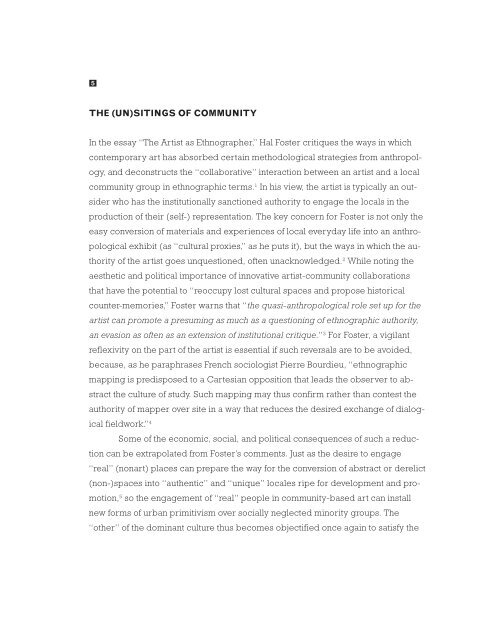ONE PLACE AFTER ANOTHER - Monoskop
ONE PLACE AFTER ANOTHER - Monoskop
ONE PLACE AFTER ANOTHER - Monoskop
You also want an ePaper? Increase the reach of your titles
YUMPU automatically turns print PDFs into web optimized ePapers that Google loves.
�<br />
THE (UN)SITINGS OF COMMUNITY<br />
In the essay “The Artist as Ethnographer,” Hal Foster critiques the ways in which<br />
contemporary art has absorbed certain methodological strategies from anthropology,<br />
and deconstructs the “collaborative” interaction between an artist and a local<br />
community group in ethnographic terms. 1 In his view, the artist is typically an outsider<br />
who has the institutionally sanctioned authority to engage the locals in the<br />
production of their (self-) representation. The key concern for Foster is not only the<br />
easy conversion of materials and experiences of local everyday life into an anthropological<br />
exhibit (as “cultural proxies,” as he puts it), but the ways in which the authority<br />
of the artist goes unquestioned, often unacknowledged. 2 While noting the<br />
aesthetic and political importance of innovative artist-community collaborations<br />
that have the potential to “reoccupy lost cultural spaces and propose historical<br />
counter-memories,” Foster warns that “the quasi-anthropological role set up for the<br />
artist can promote a presuming as much as a questioning of ethnographic authority,<br />
an evasion as often as an extension of institutional critique.” 3 For Foster, a vigilant<br />
reflexivity on the part of the artist is essential if such reversals are to be avoided,<br />
because, as he paraphrases French sociologist Pierre Bourdieu, “ethnographic<br />
mapping is predisposed to a Cartesian opposition that leads the observer to abstract<br />
the culture of study. Such mapping may thus confirm rather than contest the<br />
authority of mapper over site in a way that reduces the desired exchange of dialogical<br />
fieldwork.” 4<br />
Some of the economic, social, and political consequences of such a reduction<br />
can be extrapolated from Foster’s comments. Just as the desire to engage<br />
“real” (nonart) places can prepare the way for the conversion of abstract or derelict<br />
(non-)spaces into “authentic” and “unique” locales ripe for development and promotion,<br />
5 so the engagement of “real” people in community-based art can install<br />
new forms of urban primitivism over socially neglected minority groups. The<br />
“other” of the dominant culture thus becomes objectified once again to satisfy the

















